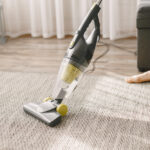Hi there, and welcome to my guide on how to prevent mold growth in your home! As a homeowner myself, I understand the importance of keeping your living space safe and healthy.
Mold is one of those things that can easily go unnoticed until it’s too late, causing health problems for you and your family as well as expensive repairs. Luckily, preventing mold growth isn’t rocket science – with a few simple steps, you can drastically reduce the risk of it taking hold in your home.
In this article, I’ll be sharing some expert tips on what causes mold, where it likes to grow, and most importantly, how you can stop it from appearing in the first place. So whether you’re dealing with an existing mold problem or simply want to stay ahead of the game, read on for everything you need to know about keeping your home free from harmful fungi.
Understanding The Causes Of Mold
Mold growth in your home can be a serious problem, not only affecting the appearance of your property but also posing health hazards to you and your family. Understanding what causes mold is crucial to preventing its growth.
One major cause of mold is excess moisture in the air or on surfaces. This can come from various sources such as leaks, condensation, high humidity levels or poor ventilation. Mold thrives in damp conditions so it’s important to keep areas dry and well-ventilated.
Another factor that contributes to mold growth is organic matter which provides nutrients for spores to grow. Common sources include wood, paper products, fabrics and even food residues left behind in kitchens or other areas with spills or crumbs. Regular cleaning and maintenance can help prevent this issue.
Additionally, temperature plays an important role in mold development. Mold grows best between 60°F (15°C) and 80°F (27°C), making indoor environments ideal breeding grounds if not properly regulated.
By understanding these causes of mold growth, we are better equipped to identify high-risk areas in our homes where preventative measures should be taken.
Identifying High-Risk Areas In Your Home
Moisture is one of the most common causes of mold growth in the home, so it’s important to identify any areas that are prone to moisture.
Poor ventilation can also increase the risk of mold growth, so regular air circulation is key.
Kitchen and bathroom areas are especially vulnerable to moisture and should be monitored frequently.
Lastly, any areas that have experienced water damage should be addressed right away to prevent mold growth.
Areas With Moisture
Are you worried about mold growth in your home? Identifying high-risk areas is the first step to preventing it. One of these areas is any space with moisture. Moisture creates a breeding ground for mold, so it’s important to keep an eye on these areas.
The most obvious place with moisture is the bathroom. Showers and baths produce steam that can settle into walls, floors, and ceilings. Regularly cleaning your bathroom will prevent mold from taking hold. Additionally, using a dehumidifier can remove excess moisture from the air.
Other places with moisture include kitchens, laundry rooms, and basements. Dishwashers and washing machines produce water vapor during use. Basements are particularly susceptible because they tend to be damp and poorly ventilated. Make sure to regularly inspect these areas for signs of mold growth.
By identifying high-risk areas like those with moisture, you’ll be able to stop mold before it becomes a problem. Keep these tips in mind as you work towards creating a healthy living environment in your home!
Poor Ventilation
Now that we’ve discussed the importance of identifying high-risk areas with moisture, let’s talk about another crucial factor in preventing mold growth: ventilation. Poor ventilation can trap moisture and create an ideal environment for mold to thrive. This is why it’s important to ensure proper airflow throughout your home.
One area where poor ventilation is common is the attic. During the winter months, warm air from inside the house rises and can become trapped in the attic without proper ventilation. This can lead to condensation on surfaces which creates a prime spot for mold growth. Installing vents or fans can help circulate air and prevent this problem.
Another place where good ventilation is essential is in crawl spaces under your home. These areas are often dark and damp, making them perfect breeding grounds for mold. A lack of ventilation can exacerbate this issue by trapping moist air and creating stagnant conditions. Properly sealing any gaps or cracks and installing vents will allow fresh air to flow through these areas, reducing the risk of mold growth.
By being aware of high-risk areas like those with poor ventilation, you’re taking steps towards keeping your home free from harmful molds. Make sure to regularly inspect these spaces and take preventative measures when necessary!
Controlling Humidity Levels
Maintaining proper humidity levels in your home is crucial when it comes to preventing mold growth. Mold thrives in moist environments, so keeping the air dry is essential. Ideally, you should aim for a relative humidity level of 30-50%.
To achieve this, consider investing in a dehumidifier. Another way to control humidity levels is by using an air conditioner during hot and humid weather. AC units not only cool the air but also remove moisture from it, making your home less hospitable for mold spores.
Additionally, make sure to fix any leaks or water damage as soon as possible since they can contribute to high indoor humidity levels. It’s important to note that excessively low humidity levels can also cause problems such as respiratory issues and dry skin. Therefore, finding a balance between too much and too little moisture is key.
Monitoring the humidity in your home regularly with a hygrometer can help you maintain optimal conditions.
As you can see, controlling the amount of moisture in the air is vital when it comes to preventing mold growth in your living space. In addition to managing humidity levels, ensuring proper ventilation and airflow throughout your home can go a long way towards maintaining healthy indoor air quality.
Proper Ventilation And Airflow
- Improving ventilation is key to preventing mold growth in your home. Good airflow keeps humidity levels low, so you want to make sure your home is well-ventilated.
- Controlling humidity is an important part of mold prevention. If the humidity levels in your home are too high, moisture will collect and create the perfect environment for mold.
- Maintaining airflow is essential for preventing mold growth. Make sure to open windows and turn on fans to keep air moving throughout the house.
- You’ll also want to check your air vents and ducts for any blockages. If air can’t freely flow throughout your home, mold will quickly become a problem.
- If your home is too humid, you can reduce moisture levels by using a dehumidifier or installing a ventilation system.
- Finally, make sure to check your roof, walls, and windows for any signs of water damage that could be causing mold growth.
Improving Ventilation
Are you tired of constantly battling against mold growth in your home? One key solution is to improve ventilation. Proper ventilation and airflow can help reduce moisture levels, which are the main culprit behind mold formation.
To get started on improving your home’s ventilation, start by opening windows whenever possible. This allows fresh air to circulate throughout your home, reducing humidity levels and preventing mold spores from settling in one place.
If you have a bathroom or kitchen without a window, consider installing an exhaust fan to remove excess moisture.
Another effective way to improve ventilation in your home is through using a dehumidifier. These appliances work by removing moisture from the air, making it difficult for mold spores to thrive. Be sure to empty the water collection tray regularly and clean the unit as recommended by the manufacturer.
Improving ventilation is just one step towards preventing mold growth in your home. By taking these small measures today, you can ensure that your living space remains healthy and free from harmful mold growth.
Controlling Humidity
Now that we have discussed the importance of proper ventilation and airflow in preventing mold growth, let us move on to another crucial factor: controlling humidity. High levels of moisture in your home can lead to a breeding ground for mold spores, making it important to keep them under control.
To start with, consider investing in a hygrometer to measure the humidity level in your home. Ideally, you should aim for a relative humidity level between 30-50%.
If the level is higher than this range, use dehumidifiers or air conditioners to reduce moisture levels.
Another way to control humidity is by fixing any leaks or water damage immediately. Moisture from these sources can quickly accumulate and create an environment favorable for mold growth.
Regularly checking pipes, faucets, roofs, walls and ceilings for signs of leakage can prevent such problems.
Lastly, ensure good insulation throughout your house as it helps maintain temperature and reduces condensation which leads to high humidity. Properly insulating windows and doors will also help minimize drafts that may introduce moist air into your home.
By improving ventilation and keeping a check on humidity levels at all times using these methods along with other preventive measures discussed before; homeowners can effectively combat against harmful mold growth in their homes.
Maintaining Airflow
Now that we have covered the importance of controlling humidity to prevent mold growth, let’s move on to another crucial factor in maintaining a healthy home environment: maintaining airflow.
Proper ventilation and air circulation are essential for preventing moisture buildup, which can lead to mold growth.
One way to ensure adequate airflow is by opening windows and doors regularly to allow fresh air to circulate throughout your home. This will not only help reduce moisture levels but also improve indoor air quality.
In areas where natural ventilation may be limited, consider installing mechanical ventilation systems such as exhaust fans or whole-house ventilators. These systems can effectively remove stale and moist air from your home while introducing fresh outdoor air into your living spaces.
Regularly cleaning these systems helps maintain their efficiency in removing excess moisture and preventing mold growth.
By improving both ventilation and airflow in your home, you can create an environment that is less susceptible to mold growth.
Remember to keep a hygrometer handy to monitor relative humidity levels and take necessary steps promptly if they exceed 50%.
With these preventive measures in place, homeowners can rest assured that their homes are protected against harmful mold spores.
Regular Cleaning And Maintenance
Regular Cleaning and Maintenance are crucial aspects in preventing mold growth in your home. Mold thrives in environments with moisture, warmth, and organic matter to feed on. Therefore, it’s important to keep surfaces clean and dry to avoid any potential breeding ground for mold spores.
Regular cleaning of bathrooms, kitchens, laundry rooms, and other areas where humidity tends to build up is essential. One simple way to reduce the likelihood of mold growth is by keeping indoor humidity below 60%. This can be achieved by using dehumidifiers or air conditioners during humid seasons or in more humid areas.
Additionally, make sure that there aren’t any leaks from pipes or roofs as they can cause moisture buildup resulting in mold growth. To further prevent the spread of mold spores within your home, ensure proper ventilation throughout the house. Open windows whenever possible especially when cooking or showering. Use bathroom fans and range hoods to remove excess moisture from these spaces. By doing so, you’re not only improving the overall quality of air but also reducing dampness which could lead to potential mold outbreaks.
Maintaining a clean environment with minimal moisture levels will greatly reduce the risk of mold growth inside your home. However, even under ideal conditions molds may still grow if certain materials used have already been contaminated with spores. In this case, you might want to consider using specific types of materials resistant against molds such as anti-microbial paints and coatings which we’ll discuss next.
Using Mold-Resistant Materials
Mold-resistant materials are an essential component of any mold prevention plan. Did you know that over 50% of homes in the United States have some form of mold growth? It’s a staggering statistic and one that should motivate homeowners to take necessary steps towards preventing mold.
Using mold-resistant drywall is one way to keep your home free from mold. This type of drywall contains fiberglass facing instead of paper, making it resistant to moisture and thus less susceptible to mold growth.
Additionally, using paint with anti-microbial properties can also help prevent mold growth on walls and ceilings.
When choosing flooring for your home, consider options that are naturally more resistant to moisture such as ceramic tile or vinyl plank flooring. These types of flooring not only look great but they’re also easier to clean and maintain than carpeting. By utilizing these materials, you’ll be able to reduce the likelihood of moisture buildup which can lead to mold growth.
Preventing mold in your home requires a multi-faceted approach, including the use of mold-resistant materials. However, even with preventative measures in place, water damage can still occur.
In the next section, we’ll discuss how addressing water damage quickly is crucial in preventing mold growth in your home.
Addressing Water Damage Quickly
Water damage is a common cause of mold growth in homes. It’s crucial to address any water damage quickly to prevent mold from growing and spreading throughout your property.
Water damage can occur due to various reasons, such as leaky pipes, roof damage, or flooding. If you notice any signs of water damage in your home, such as stains on walls or ceilings, musty odors, or dampness, take action immediately.
Ignoring these warning signs can lead to severe mold problems that may require professional intervention. The first step is to identify the source of the water damage and fix it promptly.
Once you’ve fixed the cause of the water damage, focus on drying out affected areas thoroughly. Use fans and dehumidifiers to increase air circulation and reduce humidity levels.
Additionally, remove any wet materials like carpets or furniture that cannot be salvaged. By addressing water damage quickly and effectively, you can prevent mold growth from becoming a more significant problem in your home.
It’s essential to understand that some instances of water damage are too complex for homeowners to handle on their own. Seeking professional help when needed ensures that all aspects of the restoration process are done correctly and efficiently.
A certified professional can assess the extent of the water damage and perform specialized treatments like mold remediation if necessary. Remember: time is critical when dealing with water damage; act fast!
Seeking Professional Help When Needed
Preventing mold growth in your home can be a daunting task. It’s like trying to tame a wild beast that is always lurking around every corner, ready to pounce on its prey.
You may have tried all the DIY methods available online and still find yourself struggling with persistent mold infestations.
At this point, it’s time to consider seeking professional mold inspection service. Mold remediation professionals are trained experts who know how to identify the root cause of mold growth and provide effective solutions tailored to your specific needs.
They use advanced equipment and techniques to remove existing mold colonies and prevent future ones from forming.
Hiring a professional not only saves you valuable time but also helps you avoid potential health risks associated with prolonged exposure to mold spores.
Don’t wait until the problem becomes too big to handle; consult an expert as soon as possible for a safe and healthy living environment.
Conclusion
As a home mold prevention expert, it is important to remember that mold growth can be prevented with proper maintenance and attention.
By controlling humidity levels, improving ventilation and airflow, using mold-resistant materials, and addressing water damage quickly, you can significantly reduce the risk of mold growing in your home.
Did you know that according to the Environmental Protection Agency (EPA), indoor air quality can be up to five times more polluted than outdoor air?
This is due in part to high moisture levels which create the perfect environment for mold growth.
But by following these preventative measures and seeking professional help when needed, you can ensure that your home remains a safe and healthy place for you and your family.
Remember: prevention is key!











